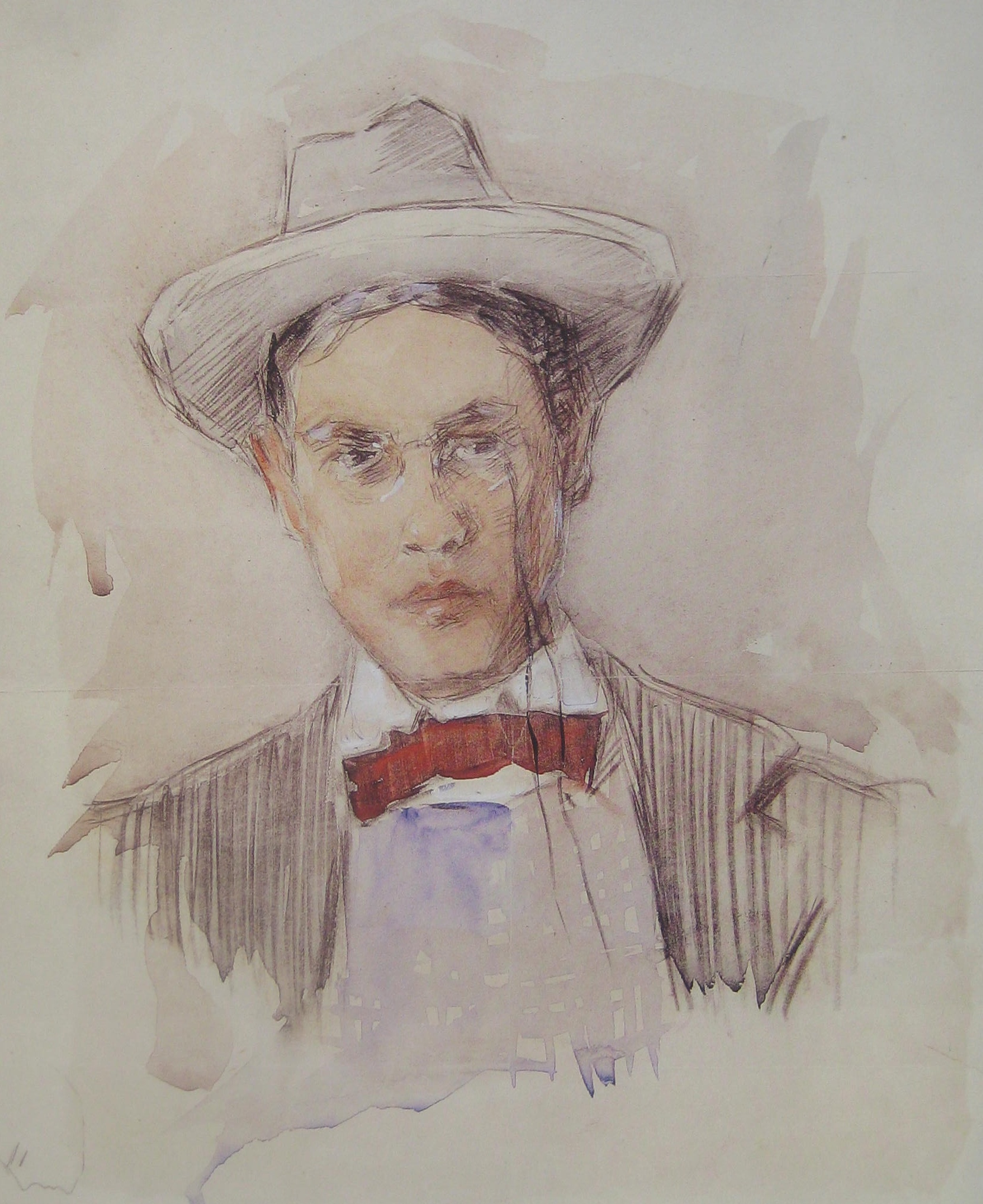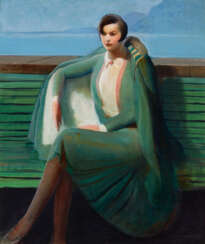
American Art

Edward Stuart Davis was an American artist, a representative of Cubism and Pop Art in painting. He was also active in politics; one of Davis's goals was to "reconcile abstract art with Marxism and modern industrial society. Along with his paintings, Davis was also an engraver and member of the Society of American Graphic Artists.

Rolph Scarlett is an American and Canadian abstraction artist. He designed sets for George Bernard Shaw's play Man and Superman and for Rockettes at Radio City Music Hall, and has painted and designed jewelry. In his artistic work, Scarlett avoided any reference to the outside world and believed that subjectless painting was an act of pure creativity. Personal exhibitions of Rolf Scarlett's works were held in many famous galleries in the United States.

Frederick Carl Frieseke was an American Impressionist painter who spent most of his life as an expatriate in France. An influential member of the Giverny art colony, his paintings often concentrated on various effects of dappled sunlight. He is especially known for painting female subjects, both indoors and out.

William Glackens was an American painter, illustrator, and journalist, one of the leading artists of American impressionism. In his youth he worked for a newspaper where he was an illustrator. Glackens later moved to New York City, where he worked as an artist and illustrator for the New York Herald and Philadelphia Press magazines and newspapers.
In the early twentieth century Glackens became known for his vivid and energetic paintings reflecting life in the city, theater productions, cafes, and parks. He was one of the founders of the Association of American Artists and was involved in the organization of the famous Armory Show in New York in 1913, which was an important event in American art history. In 1912 Gluckens met the French impressionist Pierre Auguste Renoir, who greatly influenced his style.
Gluckens was also inspired by the work of European artists Edouard Manet, Jean-Louis Forain and Gustave Caybotte. Gluckens left behind a rich legacy of vibrant, emotional works that to this day remain among the most significant in American art history.

William Glackens was an American painter, illustrator, and journalist, one of the leading artists of American impressionism. In his youth he worked for a newspaper where he was an illustrator. Glackens later moved to New York City, where he worked as an artist and illustrator for the New York Herald and Philadelphia Press magazines and newspapers.
In the early twentieth century Glackens became known for his vivid and energetic paintings reflecting life in the city, theater productions, cafes, and parks. He was one of the founders of the Association of American Artists and was involved in the organization of the famous Armory Show in New York in 1913, which was an important event in American art history. In 1912 Gluckens met the French impressionist Pierre Auguste Renoir, who greatly influenced his style.
Gluckens was also inspired by the work of European artists Edouard Manet, Jean-Louis Forain and Gustave Caybotte. Gluckens left behind a rich legacy of vibrant, emotional works that to this day remain among the most significant in American art history.

Edward Henry Potthast was an US-American Impressionist painter. He is known for his paintings of people at leisure in Central Park, and on the beaches of New York and New England.

Edward Henry Potthast was an US-American Impressionist painter. He is known for his paintings of people at leisure in Central Park, and on the beaches of New York and New England.

Frederick Carl Frieseke was an American Impressionist painter who spent most of his life as an expatriate in France. An influential member of the Giverny art colony, his paintings often concentrated on various effects of dappled sunlight. He is especially known for painting female subjects, both indoors and out.

William McGregor Paxton was an American painter. He was known for his realistic, highly polished portraits and genre scenes that often depicted wealthy, fashionable women in elegant settings.
Paxton studied at the Cowles Art School in Boston and the Academie Julian in Paris, where he was influenced by the work of the French Academic painters. He later became a prominent member of the Boston School of painters, who were known for their meticulous attention to detail and focus on classical technique.
Paxton's paintings were highly sought after by collectors and he received numerous awards and honors during his career, including the Lippincott Prize from the Pennsylvania Academy of the Fine Arts in 1906 and the National Academy of Design's Altman Prize in 1913. He also taught at several art schools, including the Museum of Fine Arts, Boston and the Art Students League of New York.
Today, Paxton's paintings are held in many important public and private collections, and his legacy continues to inspire and influence contemporary realist painters.

Max Weber, a Polish-born American painter, was a trailblazer in introducing Cubism to the United States. Born in 1881 in Bialystok Weber moved to New York at the age of ten. His early encounters with European avant-garde movements in Paris profoundly influenced his artistic style. Weber's work is noted for its daring adoption of Cubist techniques, which he melded with his personal expression and later, themes from his Jewish heritage.
Max Weber's notable works include "Chinese Restaurant" (1915), celebrated for capturing the dynamic essence of urban life through Cubist fragmentation. This piece, housed at the Whitney Museum of American Art, exemplifies his skill in conveying atmosphere and energy through abstract forms. Another significant work, "Sabbath" (1919), reflects his cultural background and is part of the Brooklyn Museum's collection. Weber's impact on American art is also marked by his role as an educator and his literary contributions, which include poems and essays on art that further articulated his artistic vision.
Max Weber's paintings are held in high esteem across major museums, including the Museum of Modern Art and the Smithsonian American Art Museum, highlighting his prominence in the art community. His legacy is that of a pioneer who not only introduced new styles to American audiences but also enriched it with his diverse cultural perspective.
For collectors and art and antiques experts, Max Weber's works represent a pivotal fusion of European avant-garde movements with American artistic trends, making his pieces highly significant in the study and collection of early modernist art.
For updates related to new product sales and auction events concerning Max Weber's work, sign up here to stay informed on the latest offerings.

Marguerite Zorach was an American Fauvist painter, textile artist, and graphic designer, and was an early exponent of modernism in America. She won the 1920 Logan Medal of the Arts.

Milton Clark Avery was an American artist who, with his wife, the artist Sally Michelle Avery, created his own "Avery style. Avery was one of the most influential abstract artists in the United States in the mid-20th century.
His work is characterized by bright colors and recognizable geometric shapes. He often used these elements to create abstract compositions in which he placed great emphasis on the harmony of color and line. In addition to abstract works, Avery also created figurative paintings, often depicting landscapes and portraits. He used bright colors and strong contrasts to create emotional depth in his works.
Avery's work is held in many museums, including the Museum of Modern Art in New York, the Guggenheim Museum, and the National Gallery of Art in Washington, DC.

Newell Convers Wyeth, better known as N.C. Wyeth, was an American painter and illustrator, celebrated for his vivid and dramatic illustrations that brought to life classic literature for the Scribner’s Illustrated Classics series. Born on October 22, 1882, in Needham, Massachusetts, Wyeth displayed artistic talent from an early age, encouraged by his supportive mother. He trained under the tutelage of Howard Pyle, the "father of American illustration," who influenced him deeply, instilling a penchant for romanticism and historical accuracy in his work.
Wyeth’s illustrations for books like "Treasure Island," "The Last of the Mohicans," and "Robinson Crusoe" are among his most famous and have left a lasting legacy in the field of American illustration. His work was characterized by a robust, painterly style that effectively conveyed the adventure and emotion of the stories he illustrated. Beyond book illustrations, Wyeth also excelled in creating murals and was commissioned to paint for various public and private institutions, including banks and schools, depicting scenes that ranged from historical narratives to allegorical themes.
Despite his commercial success, Wyeth often expressed a desire to be recognized for his personal paintings, and he struggled with the commercial constraints of illustration. He explored a variety of artistic styles throughout his career, including Impressionism and Realism, and was an adept muralist as well as a studio artist. His legacy continues to influence artists and captivates art collectors and experts in the field, securing his place as a key figure in American art history.
For those interested in staying updated on exhibitions and sales related to N.C. Wyeth, consider signing up for updates focused on his works and related auction events.

Newell Convers Wyeth, better known as N.C. Wyeth, was an American painter and illustrator, celebrated for his vivid and dramatic illustrations that brought to life classic literature for the Scribner’s Illustrated Classics series. Born on October 22, 1882, in Needham, Massachusetts, Wyeth displayed artistic talent from an early age, encouraged by his supportive mother. He trained under the tutelage of Howard Pyle, the "father of American illustration," who influenced him deeply, instilling a penchant for romanticism and historical accuracy in his work.
Wyeth’s illustrations for books like "Treasure Island," "The Last of the Mohicans," and "Robinson Crusoe" are among his most famous and have left a lasting legacy in the field of American illustration. His work was characterized by a robust, painterly style that effectively conveyed the adventure and emotion of the stories he illustrated. Beyond book illustrations, Wyeth also excelled in creating murals and was commissioned to paint for various public and private institutions, including banks and schools, depicting scenes that ranged from historical narratives to allegorical themes.
Despite his commercial success, Wyeth often expressed a desire to be recognized for his personal paintings, and he struggled with the commercial constraints of illustration. He explored a variety of artistic styles throughout his career, including Impressionism and Realism, and was an adept muralist as well as a studio artist. His legacy continues to influence artists and captivates art collectors and experts in the field, securing his place as a key figure in American art history.
For those interested in staying updated on exhibitions and sales related to N.C. Wyeth, consider signing up for updates focused on his works and related auction events.




















































